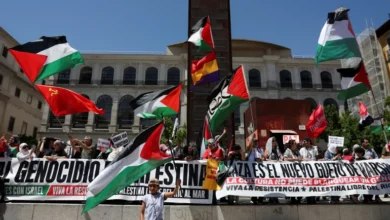The history of conflict between Hezbollah and Israel

The conflict between Hezbollah and Israel – which have been exchanging fire across the border of Israel and Lebanon since the start of the war on Gaza last October – has descended into “war”, Al Jazeera’s Zeina Khodr has reported from Beirut.
Hezbollah confirmed that its leader, Hassan Nasrallah, had been killed in an Israeli air strike on residential buildings in Beirut, which Israel claimed were above Hezbollah’s headquarters, on the night of Friday, September 27. Ali Karki, the commander of Hezbollah’s southern front, and other Hezbollah commanders, were also killed in the massive air attack on Beirut’s southern suburb of Dahiyeh on Friday, the Israeli military claimed.
On Saturday, Israel’s military said jet fighters had also attacked “dozens” of Hezbollah targets in the Bekaa Valley and various areas of southern Lebanon and the attacks are continuing.
The conflict has escalated severely since September 17, when some 2,800 people in Lebanon were injured when their pager devices exploded. At least nine people were killed, among them three children.
Most of the people injured in that attack were members of Hezbollah, which blamed the attack on Israel.
Israel has returned fire, escalating and slowing in turn against one of the region’s most experienced nongovernmental fighting groups, which is well-armed and battle-tested against it.
The conflict between the two is not new, rather it goes back nearly half a century.
Here’s a timeline:
1982 – Invasion and formation
Israel invaded Lebanon in June 1982, ostensibly in response to attacks launched on it by the Palestine Liberation Organization from southern Lebanon. Lebanon’s civil war had been raging for seven years by then.
After an agreement, the PLO left for Tunisia but Israel’s military stayed in Lebanon, supporting local proxies in the civil war and contributing to the Sabra and Shatila massacre. Right-wing Lebanese militia, in coordination with the Israeli army, killed between 2,000 and 3,500 Palestinian refugees and Lebanese civilians in two days.
Several Lebanese groups formed to repel the invasion, one was from the Shia Muslim community, traditionally a quiet demographic.
Hezbollah was the brainchild of Muslim leaders, reportedly supported by Iran, and given the mandate of repelling Israel.
Drawing support from disaffected youth and residents of the Bekaa Valley and Beirut’s southern suburbs – marginalised areas with significant Shia populations – Hezbollah quickly became a significant power in Lebanon.
1983 – Attacks
Between 1982 and 1986, a number of attacks against foreign military presences were executed and claimed by various groups, but many were blamed on Hezbollah.
On October 23, 1983, the bombing of several barracks buildings in the capital, Beirut, killed more than 300 French and American peacekeepers.
1985 – Growth of Hezbollah
By 1985, Hezbollah’s fighting power grew to the point that it, along with allied groups, was able to force the Israeli army to withdraw to the Litani River in south Lebanon.
Israel declared what it called a “security zone” along swaths of the Lebanese-Israeli border.
Policing that security zone was the Christian-dominated South Lebanon Army (SLA), typically reported as an Israeli proxy force, which continued to support the occupation of south Lebanon until Israel’s withdrawal in 2000.
1992 – Politics
In 1992, after Lebanon’s civil war (1975-1992) ended, Hezbollah entered parliamentary politics, winning eight seats in Lebanon’s 128-seat assembly.
Hezbollah’s seats have increased and the group and its allies now have 62 seats in parliament.










